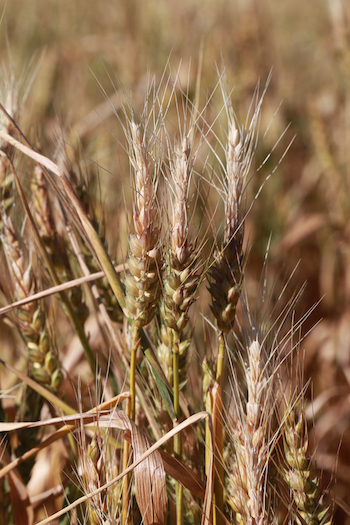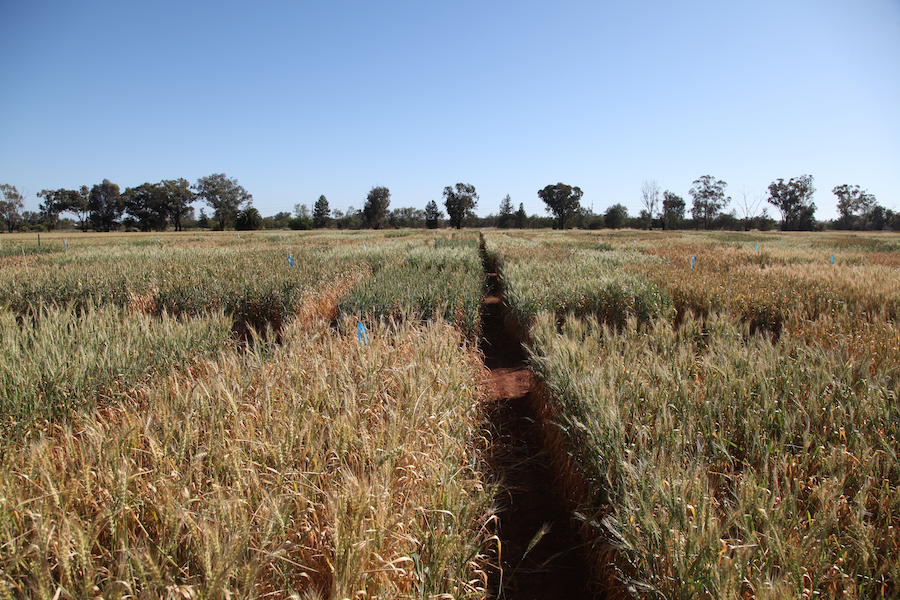First came the discovery that abiotic stresses – drought, heat or frost – reduce wheat yields by making pollen sterile during reproductive stages of development. Now, Dr Rudy Dolferus at CSIRO Agriculture and Food has achieved the holy grail of stress research.
He has identified genetic variants that protect pollen development from drought stress and developed wheat lines that can maintain yield under drought conditions in field trials.
Dr Dolferus says the new drought tolerance is composed of two distinct genetic mechanisms. When combined, they have a dual impact that helps plants to better maintain both grain number and grain size.
One of the traits has been mapped to a sub-region of the wheat genome called chromosome 5A. The other genetic trait is about to be mapped.
“The point of difference with this research is that we didn’t start out trying to understand drought stress in the field, where many different stresses converge and vastly complicate the genetic analysis,” he says.
“Instead, we started out by carefully controlling the environment so we could focus on the plant’s response to drought. We also did the analysis through the prism of pollen sterility rather than yield, since yield is a complex trait that can confound the analysis.”
Wheat lines containing the drought tolerance genetics – along with the means to select for tolerance – are now ready for handover to commercial breeders.
The discovery is the result of three consecutive GRDC investments that Dr Dolferus says allowed him to carefully dissect stress-related biological impacts and work through a hierarchy of biological responses that led to the identification of the new genetics.
Outsmarting complexity
The dissection of wheat’s response to drought was undertaken in controlled-environment experiments in which Dr Dolferus could vary the timing, duration and intensity of drought stress. This set-up also allowed him to avoid any other stresses that would have confounded the analysis.
That level of control meant the CSIRO team could meticulously work back from pollen biology to a hierarchy of determinants of a plant’s drought response.
That detective work starts with the observation that pollen development is an extremely energy-intensive process. This means plants must maintain photosynthesis during flowering to provide the sugars needed for pollen development.
In turn, leaves must maintain open stomata so that the plant can exchange gases and acquire the carbon dioxide needed to make sugars.
Open stomata, however, also cause plants to lose water through evaporation.
 Drought-mediated pollen sterility is an important cause of reduced wheat yields following terminal droughts. Photo: CSIRO
Drought-mediated pollen sterility is an important cause of reduced wheat yields following terminal droughts. Photo: CSIRO
“Plants that respond to water stress by closing their stomata do conserve water and that response can improve water use efficiency during vegetative stages of growth,” Dr Dolferus says. “Closed stomata during flowering, however, inhibit photosynthesis and that can lead to sterile pollen and the yield losses that we associate with terminal droughts.”
Dr Dolferus found that two opposing hormone systems essentially underlie when and why a plant will close stomata in response to water stress.
In sensitive wheat lines, drought stress induces production of the hormone ABA (abscisic acid). It mediates the closure of stomata, which inhibits photosynthesis, sugar metabolism, pollen development and yield.
In tolerant wheat lines, the auxin hormones dominate. They induce signals that allow the stomata to remain open during a critical 10-day window of the reproductive stage of development.
“Ultimately, the level of drought tolerance that is possible in wheat is determined by the threshold level at which the water stress becomes too severe and the ABA hormones take over,” Dr Dolferus says.
That finding could refocus future work on screening genetically diverse populations for variants that have a higher threshold before ABA takes over from auxin-mediated growth.
Dissecting stress tolerance
The transition from physiological to the genetic level was made using two wheat mapping populations.
The first and better-characterised population exploited the genetic diversity of the Halberd and Cranbrook cultivars. Genetic mapping implicated variation within the auxin gene family among the regions of the genome that mediate responses to drought.
The second population tapped even greater levels of genetic diversity by using a synthetic wheat as a parent. This population is still being mapped, but there are indications it may contain even higher levels of drought tolerance.

The right genetics help wheat maintain photosynthesis under water stress, ensuring that enough sugars are made for the production of fertile pollen. Photo: CSIRO
The most drought-tolerant and susceptible lines from these populations underwent field validation trials, with the 2019 season providing ideal drought conditions at the test sites in NSW. This work was performed in collaboration with the NSW Department of Primary Industries (DPI) and Dr Felicity Harris. Trials were carried out at the GRDC Managed Environment Facility in Yanco, NSW, and at the NSW DPI trial sites in Wagga Wagga and Wallendbeen, NSW.
“We now have lines that can serve as parents to transfer drought tolerance into breeding programs but also serve as controls when screening additional genetic diversity for stronger forms of tolerance,” Dr Dolferus says. “DNA markers are also available to select for the genetics that maintain grain number during terminal droughts, with ongoing work needed to identify markers for the genetics that help maintain grain size.”
In addition, Dr Dolferus has developed new protocols and caveats to aid in drought-related breeding, including:
- the importance of monitoring a plant’s water content during critical stages of flowering to determine when and if plants are water stressed;
- the need for advanced knowledge about soil type and soil water content to anticipate the rate of soil drying when temperatures increase;
- the importance of selecting contrasting environments for drought trials to evaluate genetically diverse germplasm; and
- the need to include control lines that provide information about the drought conditions during the trial.
Looking ahead
Dr Dolferus is leaving CSIRO but hopes his wheat drought research can help progress other environmental stresses – particularly heat, chilling and frost stress – and other crops, including pulses.
“What has changed in stress-related research is a shift away from yield – which is affected by everything – and from purely morphological (or externally observable) traits to more specific physiological and cellular adaptations to stress,” he says.
“The better we can phenotype how plants respond to stress down to the cellular, metabolic and molecular scales, the better we become at exploiting genetic diversity that associates with greater stress tolerance.”
That approach is underway for chilling and frost tolerance with the focus of phenotyping targeting more specific responses, such as metabolites and the lipidome (which involves analysis of the totality of lipids in cells). A similar targeted approach could be applied to other stresses.
In addition, recent findings have found that auxin hormones play a role in frost tolerance in wheat as well. But auxin hormones are encoded by a large gene family and different sets of genes are implicated in drought and frost responses.
“Response to environmental stresses such as drought and cold tend to involve large multi-gene families – as is the case for the auxin response genes,” Dr Dolferus says. “It looks like nature has evolved specialised genes to respond to different stresses within the same family of genes.
“This served to improve adaptability of plants during evolution, but it complicates genetic analysis and phenotyping needs to be more focused and targeted to specific mechanisms involved in stress tolerance.”
Ultimately, it is that gain in phenotyping capability applied hierarchically within metabolic, cellular and molecular responses that Dr Dolferus believes will allow for ongoing genetic gain in stress tolerance.
More information: Rudy Dolferus, rudy.dolferus@csiro.au

























































